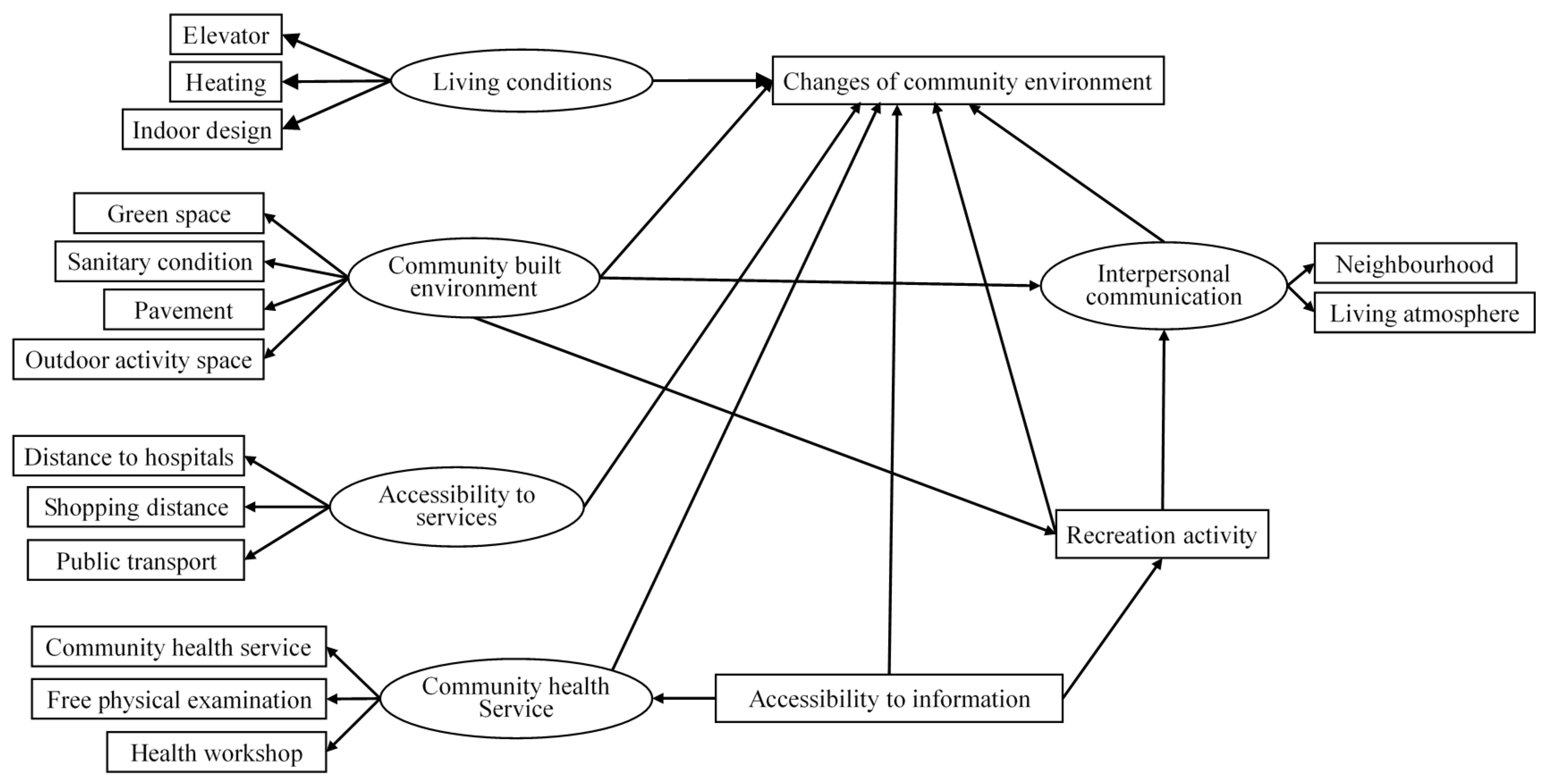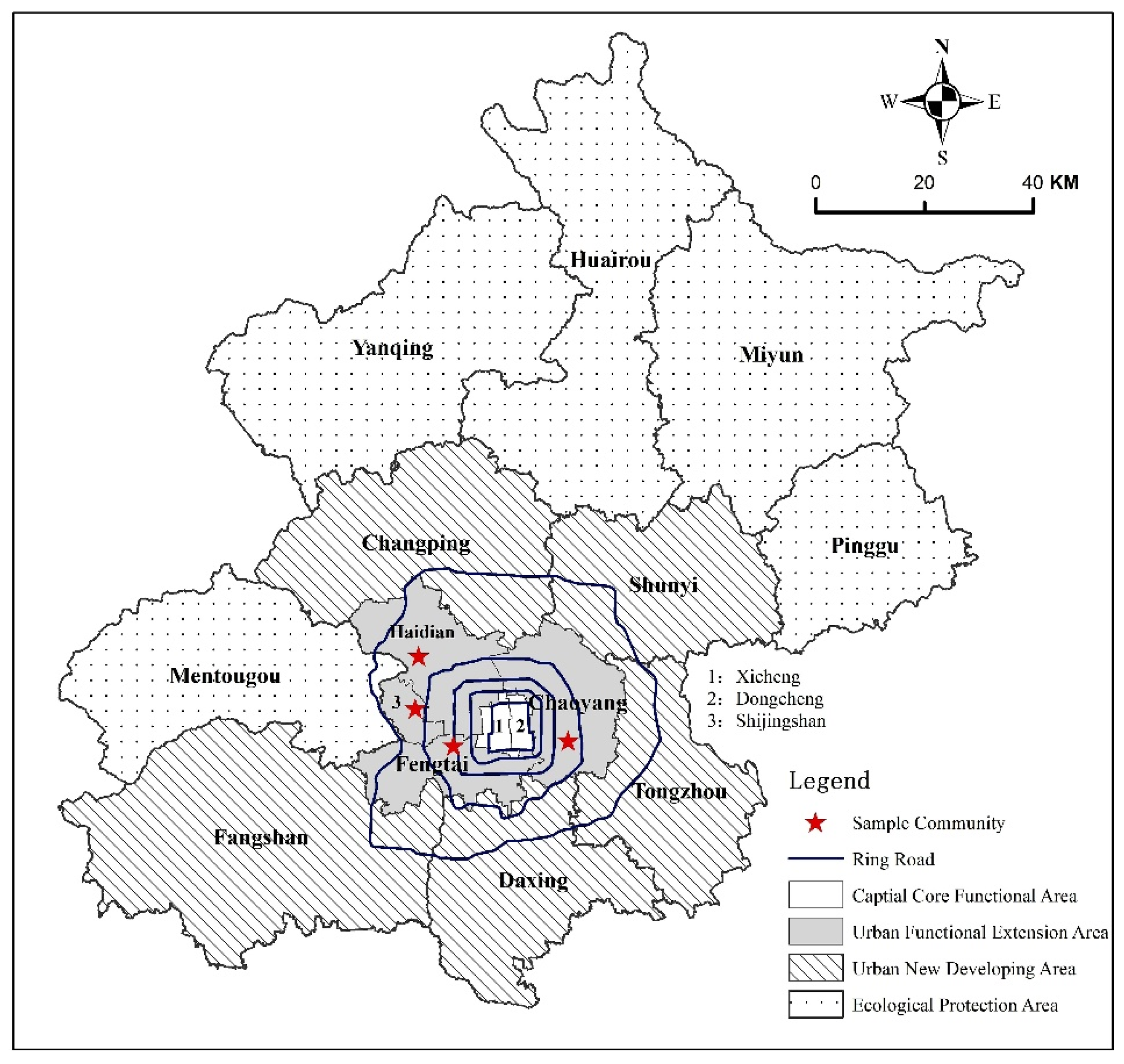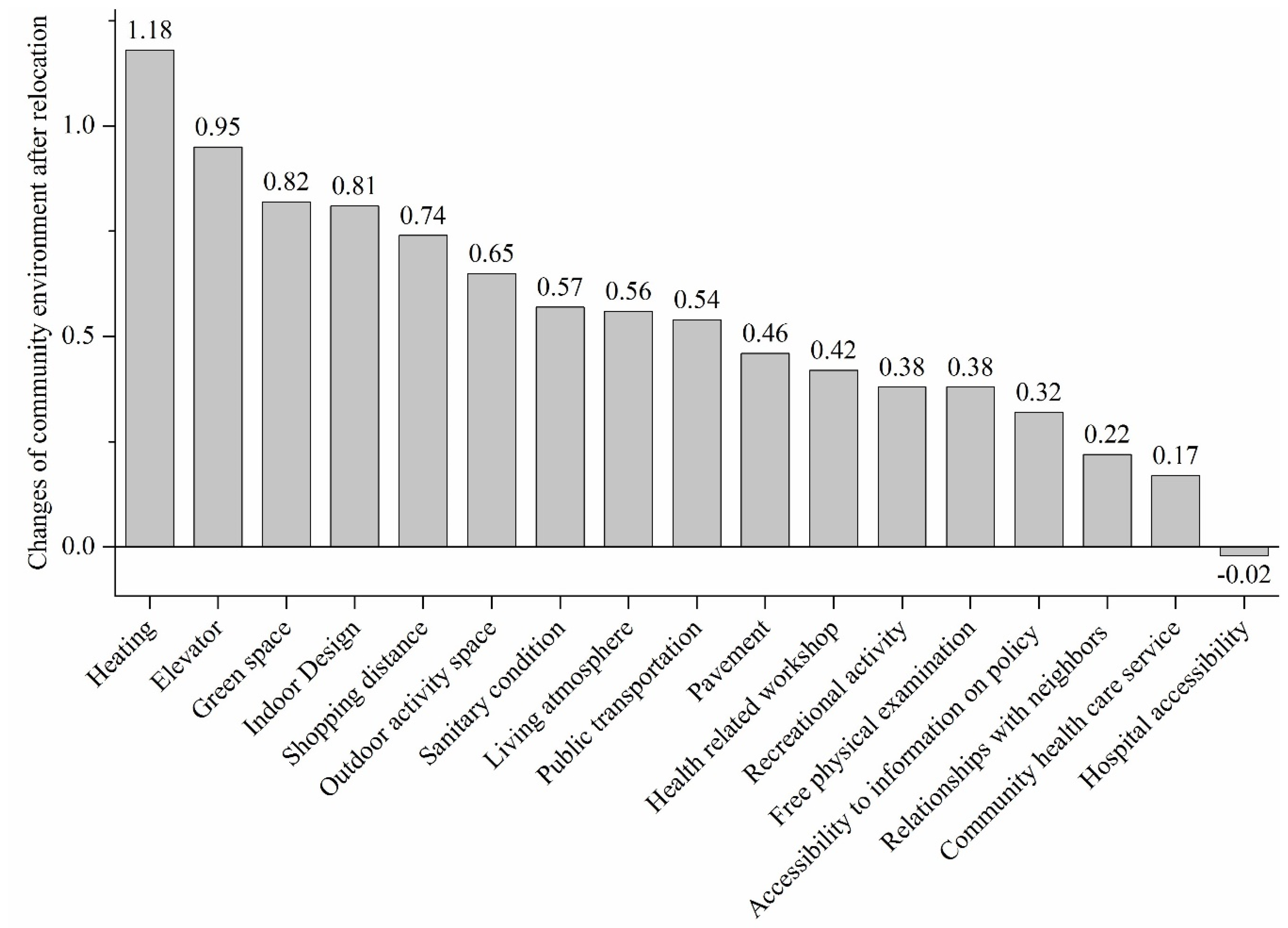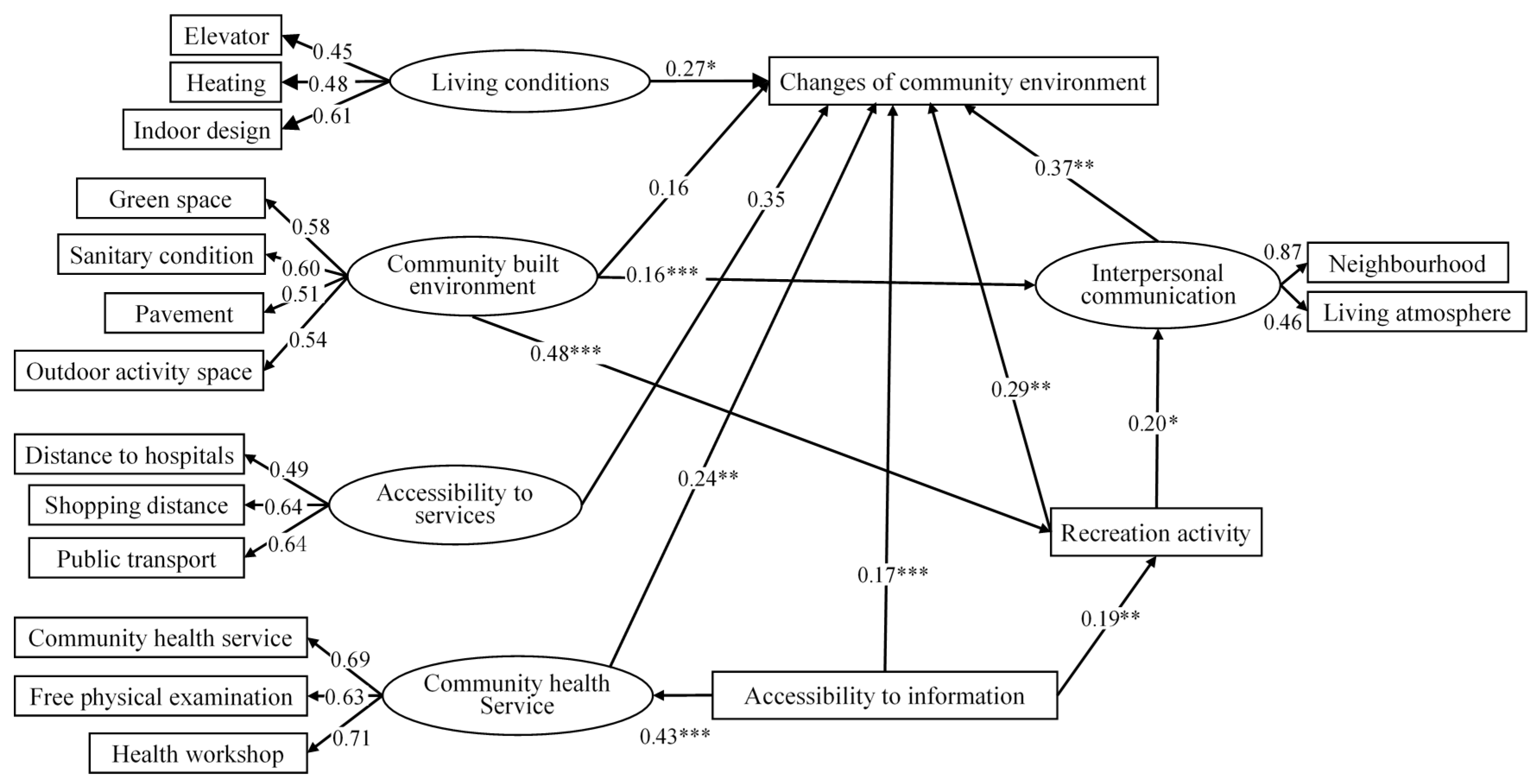Older People’s Perception of Changes in Their Living Environment after Relocation: A Case Study in Beijing, China
Abstract
1. Introduction
2. Literature Review
2.1. Elderly Relocation
2.2. Age-Friendly Community
3. Data and Method
3.1. Structural Equation Modeling
3.2. Measurement
4. Results
4.1. The Changes in Community Environment after Relocation
4.2. Determinants of Community Environment
5. Discussion
6. Conclusions
Author Contributions
Funding
Conflicts of Interest
Appendix A. Questionnaire: Changes of community environments for older people in Beijing
| Elements of livable community environment | 1 | 2 | 3 | 4 | 5 |
| Heating | |||||
| Elevator | |||||
| Indoor design | |||||
| Green space | |||||
| Sanitary condition | |||||
| Pavement | |||||
| Outdoor activity space | |||||
| Hospital accessibility | |||||
| Shopping distance | |||||
| Public transportation | |||||
| Community health care service | |||||
| Free physical examination | |||||
| Health related workshop | |||||
| Living atmosphere | |||||
| Neighborhood interpersonal relationship | |||||
| Recreational activity | |||||
| Accessibility to information on policy |
References
- IUSSP. Multilingual demographic dictionary. In Multilingual Demographic Dictionary, 2nd ed.; Ordina Editions: Liege, Belgium, 1982. [Google Scholar]
- Beijing Municipality Bureau of Statistics (BMBS). Tabulation on the 2000. Population Census of Beijing Municipality; China Statistics Press: Beijing, China, 2002.
- Beijing Municipal Civil Affairs Bureau. Report on the Development of Undertakings for the Aged and Elderly Care Services in Beijing (2018); Social Science Academic Press: Beijing, China, 2019.
- Beijing Municipality Bureau of Statistics (BMBS). Tabulation on the 2010. Population Census of Beijing Municipality; China Statistics Press: Beijing, China, 2012.
- Yang, K. From” Danwei” society to new community building: Opportunities and challenges for citizen participation in Chinese cities. Chin. Public Admin. Rev. 2006, 1, 65–82. (In Chinese) [Google Scholar] [CrossRef][Green Version]
- He, H. The change of urban basic level social management system in China: From Danwei system, street residential system to community system. Mgmt. Wld 2003, 6, 52–62. (In Chinese) [Google Scholar]
- Zhan, H.J.; Montgomery, R.J.V. Gender And Elder Care In China:The Influence of Filial Piety and Structural Constraints. Gend. Soc. 2003, 17, 209–229. [Google Scholar] [CrossRef]
- Pinquart, M.; Sörensen, S. Influences of socioeconomic status, social network, and competence on subjective well-being in later life: A meta-analysis. Psychol. Aging 2000, 15, 187–224. [Google Scholar] [CrossRef] [PubMed]
- Rogers, A.; Castro, L.J. Model Migration Schedules; International Institute for Applied Systems Analysis: Laxenburg, Austria, 1981. [Google Scholar]
- Longino, C.F.; Perzynski, A.T.; Stoller, E.P. Pandora’s Briefcase: Unpacking the Retirement Migration Decision. Res. Aging 2002, 24, 29–49. [Google Scholar] [CrossRef]
- Chevan, A. Holding On and Letting Go: Residential Mobility During Widowhood. Res. Aging 1995, 17, 60–61. [Google Scholar] [CrossRef]
- Al-Hamad, A.; Flowerdew, R.; Hayes, L. Migration of elderly people to join existing households: Some evidence from the 1991 Household Sample of Anonymised Records. Environ. Plan. 1997, 29, 243–255. [Google Scholar] [CrossRef]
- Sander, N.; Bell, M. Migration and retirement in the life course: An event history approach. Popul. Res. 2013, 31, 1–27. [Google Scholar] [CrossRef]
- Diepen, A.M.L.; Mulder, C.H. Distance to family members and relocations of older adults. J. Hous. Built Environ. 2009, 24, 31–46. [Google Scholar] [CrossRef]
- De Jong, G.F.; Wilmoth, J.M.; Angel, J.L.; Cornwell, G.T. Motive and the geographic mobility of very old Americans. J. Gerontol. 1995, 50, S395–S404. [Google Scholar] [CrossRef]
- Buurman, B.M.; Trentalange, M.; Nicholson, N.R.; McGloin, J.M.; Gahbauer, E.A.; Allore, H.G.; Gill, T.M. Residential Relocations Among Older People Over the Course of More Than 10 Years. J. Am. Med. Dir. Assoc. 2014, 15, 521–526. [Google Scholar] [CrossRef] [PubMed]
- Duncombe, W.; Robbins, M.; Wolf, D.A. Place characteristics and residential location choice among the retirement-age population. J. Gerontol. 2003, 58, S244. [Google Scholar] [CrossRef] [PubMed]
- Geller, A.M.; Zenick, H. Aging and the Environment: A Research Framework. Environ. Health Perspect. 2005, 113, 1257–1262. [Google Scholar] [CrossRef] [PubMed]
- Hwang, E.; Cummings, L.; Sixsmith, A.; Sixsmith, J. Impacts of Home Modifications on Aging-in-Place. J Hous. Elder. 2011, 25, 246–257. [Google Scholar] [CrossRef]
- Walters, W.H. Place characteristics and later-life migration. Res. Aging 2002, 24, 243–277. [Google Scholar] [CrossRef]
- Somenahalli, S.; Shipton, M. Examining the Distribution of the Elderly and Accessibility to Essential Services. Procedia Soc. Behav. Sci. 2013, 104, 942–951. [Google Scholar] [CrossRef]
- Jauhiainen, J.S. Will the retiring baby boomers return to rural periphery? J. Rural Stud. 2009, 25, 25–34. [Google Scholar] [CrossRef]
- Alsnih, R.; Hensher, D.A. The mobility and accessibility expectations of seniors in an aging population. Transp. Res. Part A-Policy Pract. 2003, 37, 903–916. [Google Scholar] [CrossRef]
- Oh, J.H. Social Bonds and the Migration Intentions of Elderly Urban Residents: The Mediating Effect of Residential Satisfaction. Popul. Res. Policy Rev. 2003, 22, 127–146. [Google Scholar] [CrossRef]
- Spina, J.; Smith, G.C.; Deverteuil, G.P. The relationship between place ties and moves to small regional retirement communities on the Canadian prairies. Geoforum 2013, 45, 230–239. [Google Scholar] [CrossRef]
- Kim, J.-H.; Han, J.H. Myths of migration on retirement in Korea: Do the elderly move to less dense areas? Habitat Int. 2014, 41, 195–204. [Google Scholar] [CrossRef]
- Du, P.; Wang, W. The difference of urban and rural ageing and its transaction. Popul. Res. 2010, 2, 3–10. (In Chinese) [Google Scholar]
- Wu, Y. One-Child policy and elderly migration. Sociol. Stud. 2013, 4, 1–25. (In Chinese) [Google Scholar]
- Luo, G. China’s Family Support System: Impact of Rural–Urban Female Labor Migration; Chen, S., Powell, J.L., Eds.; Springer: New York, NY, USA, 2012; Volume 2, pp. 99–126. [Google Scholar]
- Liu, Q.; Feng, L. The empreical study of social relationship of elderly migration in Shenzhen. Chin. J. Gerontol. 2015, 18, 5347–5349. (In Chinese) [Google Scholar]
- Jiang, X.; Ji, Y.; Chang, F. Analysis of Old People’ s Wishes of Offsite Pension in Beijing. Soc. Sci. Beijing 2012, 118, 33–37. (In Chinese) [Google Scholar]
- Zhou, J.S. Urban elderly: Housing and willingness to migration: Analysis on the 2006 survey of urban and rural older population in China. Constr. Econ. 2012, 11, 71–75. (In Chinese) [Google Scholar]
- Zhang, H.; Li, S. The type of intergenration economy flow in the urban old peope’s families and its influencing factors: A case study in Shanghai. South. Chin. Popul. 2008, 23, 15–20. (In Chinese) [Google Scholar]
- Ding, Z.; Jiang, X. Empirical Analysis on the Will of the Supporting the Aged in Different Areas in Beijing. Popul. Dev. 2011, 17, 65–69. (In Chinese) [Google Scholar]
- Zhang, X. The Research of the Special Distribution of the Aging of Population and Migration of the Aged People in Guangzhou; Sun Yat-sen University: Guangzhou, China, 2007. [Google Scholar]
- Zhou, H. The study of interprovincial migration of older people. Chin. J. Popul. Sci. 2002, 2, 35–41. (In Chinese) [Google Scholar]
- Meng, X.; Jiang, X.; Song, J.; Wan, H.; Chen, Y.; Han, Z.; He, Y. The Floating Elderly Population in Beijing: Characteristics and Determinants. Popul. Res. 2004, 28, 53–59. (In Chinese) [Google Scholar]
- Li, S. Study on influence factors for migrant elderly social adaptation. Chin. J. Gerontol. 2011, 31, 2301–2303. (In Chinese) [Google Scholar]
- Li, S. Factors Influencing Elderly’s Residential Satisfaction under the Forced Relocation of Urban Redevelopment; The University of Hong Kong: Hong Kong, China, 2013. [Google Scholar]
- Wang, M.; Yang, Y.; Jin, S.; Gu, L.; Zhang, H. Social and cultural factors that influence residential location choice of urban senior citizens in China—The case of Chengdu city. Habitat Int. 2016, 53, 55–65. [Google Scholar] [CrossRef]
- Cuba, L. Retiring to vacationland: From visitor to resident. Gener. -J. Am. Soc. Aging 1989, 13, 63–67. [Google Scholar]
- Cutchin, M.P. Deweyan integration: Moving beyond place attachment in elderly migration theory. Int. J. Aging Hum. Dev. 2001, 52, 29–44. [Google Scholar] [CrossRef] [PubMed]
- Chui, E. Ageing in Place in Hong Kong—Challenges and Opportunities in a Capitalist Chinese City. Ageing Int. 2008, 32, 167–182. [Google Scholar] [CrossRef]
- Bradley, D.E.; Longino, C.F. Geographic Mobility and Aging in Place. In International Handbook of Population Aging; Uhlenberg, P., Ed.; Springer: Dordrecht, The Netherlands, 2009; pp. 319–339. [Google Scholar]
- Liu, Q.; Chen, S. The elderly migration’s social adaption: Internal structure, status and influential factors. S. Chin. Popul. 2015, 30, 59–67. (In Chinese) [Google Scholar]
- Plouffe, L.A.; Garon, S.; Brownoff, J.; Eve, D.; Foucault, M.L.; Lawrence, R.; Lessard-Beaupré, J.P.; Toews, V. Advancing Age-Friendly Communities in Canada. Can. Rev. Soc. Pol. 2012, 68, 24–38. [Google Scholar]
- Harrell, R.; Lynott, J.; Guzman, S.; Lampkin, C. What Is Livable? Community Preferences of Older Adults; AARP: Washington, DC, USA, 2014. [Google Scholar]
- Marston, H.R.; van Hoof, J. “Who Doesn’t Think about Technology When Designing Urban Environments for Older People?” A Case Study Approach to a Proposed Extension of the WHO’s Age-Friendly Cities Model. Int. J. Environ. Res. Public Health 2019, 16, 3525. [Google Scholar] [CrossRef]
- Berke, E.M.; Gottlieb, L.M.; Sc, A.V.M.D.E.; Larson, E.B. Protective Association Between Neighborhood Walkability and Depression in Older Men. J. Am. Geriatr. Soc. 2007, 55, 526–533. [Google Scholar] [CrossRef]
- Cachadinha, C. Characteristics of an age-friendly neighbourhood built environment: Comparison of age-friendly community models with empirical evidence. In Proceedings of the Iahs World Congress on Housing Science: Visions for the Future of Housing: Mega Cities, Istanbul, Turkey, 16–19 April 2012. [Google Scholar]
- Kearns, A.; Mason, P. Regeneration, relocation and health behaviours in deprived communities. Health Place 2015, 32, 43–58. [Google Scholar] [CrossRef]
- Menec, V.H.; Means, R.; Keating, N.; Parkhurst, G.; Eales, J. Conceptualizing age-friendly communities. Can. J. Aging 2011, 30, 479–493. [Google Scholar] [CrossRef] [PubMed]
- Smith, R.J.; Lehning, A.J.; Dunkle, R.E. Conceptualizing age-friendly community characteristics in a sample of urban elders: An exploratory factor analysis. J. Gerontol. Soc. Work 2013, 56, 90–111. [Google Scholar] [CrossRef] [PubMed]
- Emlet, C.A.; Moceri, J.T. The importance of social connectedness in building age-friendly communities. J. Aging Res. 2012, 2012, 367. [Google Scholar] [CrossRef] [PubMed]
- Everingham, J.A.; Petriwskyj, A.; Warburton, J.; Cuthill, M.; Bartlett, H. Information Provision for an Age-Friendly Community. Ageing Int. 2009, 34, 79–98. [Google Scholar] [CrossRef]
- Fiori, K.L. Social network typologies and mental health among older adults. J. Gerontol. Ser. B-Psychol. Sci. Soc. Sci. 2006, 61, 25–32. [Google Scholar] [CrossRef] [PubMed]
- Lum, T.Y.; Lightfoot, E. The effects of volunteering on the physical and mental health of older people. Res. Aging 2005, 27, 31–55. [Google Scholar] [CrossRef]
- Uchino, B.N. Social Support and Physical Health: Understanding the Health Consequences of Relationships. Am. J. Epidemiol. 2004, 10, 102–111. [Google Scholar]
- Gu, Z.; Chai, Y. Study on the Elderly-Livability of Danwei Community Under the Background of Aging society: A Case Study of Yan-Dong-Yuan in Peking University. Urban Stud. 2012, 19, 89–95. (In Chinese) [Google Scholar]
- He, Q.; Zhang, S.; Wang, P. The relationship between community administration and the elderly’ subjective well-being under the activity background of “elderly livable community”. Northwest Popul. J. 2015, 36, 75–79. (In Chinese) [Google Scholar]
- Yan, B.; Gao, X. Home care satisfaction analysis of aging urban Chinese populations: Potential factors and community difference analysis. Geogr. Res. 2013, 32, 1269–1279. (In Chinese) [Google Scholar]
- Buffel, T.; Phillipson, C.; Scharf, T. Ageing in urban environments: Developing ‘age-friendly’ cities. Crit. Soc. Policy 2012, 32, 597–617. [Google Scholar] [CrossRef]
- Fitzgerald, K.G.; Caro, F.G. An Overview of Age-Friendly Cities and Communities Around the World. J. Aging Soc. Policy 2014, 26, 1–18. [Google Scholar] [CrossRef] [PubMed]
- Buffel, T.; McGarry, P.; Phillipson, C.; De Donder, L.; Dury, S.; De Witte, N.; Smetcoren, A.-S.; Verté, D. Developing Age-Friendly Cities: Case Studies From Brussels and Manchester and Implications for Policy and Practice. J. Aging Soc. Policy 2014, 26, 52–72. [Google Scholar] [CrossRef] [PubMed]
- Wang, F.; He, P.; Yuan, C.; Wang, S. Isolated or integrated? Evaluation of ageing-friendly communities in Old Beijing City based on accessibility, social inclusion and equity. Indoor Built Environ. 2020, 29, 465–479. [Google Scholar] [CrossRef]
- Joreskog, K.; Sorbom, D. LISREL8: User’s Reference Guide; Scientific Software International: Uppsala, Sweden, 1996. [Google Scholar]
- Steiger, J.H. Understanding the limitations of global fit assessment in structural equation modeling. Pers. Individ. Differ. 2007, 42, 893–898. [Google Scholar] [CrossRef]
- Rigdon, E.E. CFI versus RMSEA: A comparison of two fit indexes for structural equation modeling. Struct. Equ. Modeling A Multidiscip. J. 1996, 3, 369–379. [Google Scholar] [CrossRef]
- Hatcher, L.; Stepanski, E.J. A Step-by-Step Approach to Using the SAS System for Univariate and Multivariate Statistics; SAS Institute: Cary, NC, USA, 1994. [Google Scholar]
- Beijing Municipal Civil Affairs Bureau. Report on the Development of Undertakings for the Aged and Elderly Care Services in Beijing (2016–2017); Social Science Academic Press: Beijing, China, 2018. (In Chinese)
- Kemperman, A.; Timmermans, H. Green spaces in the direct living environment and social contacts of the aging population. Landsc. Urban Plan. 2014, 129, 44–54. [Google Scholar] [CrossRef]
- Bedimo-Rung, A.L.; Mowen, A.J.; Cohen, D.A. The significance of parks to physical activity and public health: A conceptual model. J. Prev. Med. 2005, 28, 159. [Google Scholar] [CrossRef]
- Menec, V.H.; Hutton, L.; Newall, N.; Nowicki, S.; Spina, J.; Veselyuk, D. How ‘age-friendly’ are rural communities and what community characteristics are related to age-friendliness? The case of rural Manitoba, Canada. Ageing Soc. 2013, 35, 203–223. [Google Scholar] [CrossRef]
- Li, B.; Zhang, W.; Hong, X. The study of community home based eldercare system- a case study of Yuetan community in Beijing. J. Beijing Admin. Inst. 2008, 53, 79–83. (In Chinese) [Google Scholar]




| No. | Community | Type of Housing in the Community | Description of the Older Residents | Location | Construction Time | Population | Proportion of Older People | Older People with Beijing Household Registration | Sample Size |
|---|---|---|---|---|---|---|---|---|---|
| 1 | Beichenfudi | Social housing with price and area limits, social housing for renting | Elderly relocation because of housing demolition or retirees who rent houses | Chaoyang District, eastern 5th ring | 2011 | 15,000 | 13.0% | 2000 | 167 |
| 2 | Chang’anxincheng | Economically affordable housing | Retirees who moved in for improving living conditions or living with children | Fengtai District between western 4th and 5th ring | Stage 1: 2001; Stage 2: 2007 | 12,000 | 17.5% | 1000 | 84 |
| 3 | Xishanfenglin | Economically affordable housing | Retirees who moved in for improving living conditions or living with children | Shijingshan District, western 5th ring | 2006 | 4987 | 13.3% | 440 | 43 |
| 4 | Shuianwenquan | Resettlement after demolition and social housing for renting | Elderly relocation because of housing demolition or retirees who rent houses | Haidian District, between 5th ring and 6th ring | 2014 | 7868 | 9.9% | 776 | 65 |
| Variables | Attributes | Percentage of the Total (n) | Variables | Attributes | Percentage of the Total (n) |
|---|---|---|---|---|---|
| Sex | Male | 42 (150) | Income (RMB) | 0–1000 | 6 (20) |
| Female | 58 (203) | 1000–2000 | 7 (25) | ||
| 2000–3000 | 15 (54) | ||||
| Age | 60–69 | 56 (196) | 3000–4000 | 24 (83) | |
| 70–79 | 30 (106) | 4000 and over | 48 (171) | ||
| 80 and over | 14 (51) | Pension | 91 (322) | ||
| Marital status | Source of income (multiple choice) | Supports from the children | 8 (28) | ||
| Married/partnered | 68 (240) | Allowance | 3 (10) | ||
| Not married/partnered | 32 (113) | Salary | 2 (7) | ||
| Property income | 7 (24) | ||||
| Educational level | Never went to school | 9 (33) | Living arrangements (multiple choice) | Living with spouse | 41 (143) |
| Primary school | 16 (56) | Living with adult children | 19 (66) | ||
| Junior high school | 26 (93) | Living with adult children and grandchildren | 12 (44) | ||
| High school | 25 (89) | Living with spouse and adult children | 12 (43) | ||
| Technical school/college | 15 (51) | Living with spouse, adult children and grandchildren | 10 (35) | ||
| Bachelor’s degree or above | 9 (31) | Living alone | 6 (21) | ||
| Living with relatives/friends | 0 (1) | ||||
| Causes of relocation | Moving because of demolition | 31 (108) | |||
| Moving because of other reasons | 69 (245) |
| Changes in Community Environments | Percentage |
|---|---|
| Improved a lot | 13.0 |
| Improved | 60.2 |
| Unchanged | 18.3 |
| Deteriorated | 6.2 |
| Deteriorated a lot | 2.3 |
| Variable | 1 | 2 | 3 | 4 | 5 | 6 | 7 | 8 | 9 | 10 | 11 | 12 | 13 | 14 | 15 | 16 | 17 | 18 |
|---|---|---|---|---|---|---|---|---|---|---|---|---|---|---|---|---|---|---|
| A. Living conditions | ||||||||||||||||||
| 1. Elevator | 1 | |||||||||||||||||
| 2. Heating | 0.41 | 1 | ||||||||||||||||
| 3. Indoor design | 0.30 | 0.36 | 1 | |||||||||||||||
| B. Community-built environment | ||||||||||||||||||
| 4. Green space | 0.21 | 0.04 | 0.07 | 1 | ||||||||||||||
| 5. Sanitary condition | 0.13 | 0.20 | 0.17 | 0.40 | 1 | |||||||||||||
| 6. Pavement | 0.15 | 0.13 | 0.14 | 0.23 | 0.34 | 1 | ||||||||||||
| 7. Outdoor activity space | 0.20 | 0.10 | 0.15 | 0.36 | 0.23 | 0.33 | 1 | |||||||||||
| C. Accessibility to service | ||||||||||||||||||
| 8. Distance to hospital | 0.04 | 0.02 | 0.02 | 0.16 | 0.15 | 0.24 | 0.21 | 1 | ||||||||||
| 9. Shopping distance | 0.16 | 0.05 | 0.07 | 0.27 | 0.10 | 0.25 | 0.30 | 0.32 | 1 | |||||||||
| 10. Public transport | 0.13 | 0.07 | 0.06 | 0.21 | 0.23 | 0.30 | 0.27 | 0.37 | 0.41 | 1 | ||||||||
| D. Interpersonal communication | ||||||||||||||||||
| 11. Neighborhood | 0.11 | 0.04 | 0.05 | 0.21 | 0.24 | 0.21 | 0.18 | 0.30 | 0.37 | 0.25 | 1 | |||||||
| 12. Social environment for ageing | 0.14 | 0.22 | 0.12 | 0.22 | 0.27 | 0.16 | 0.17 | 0.17 | 0.18 | 0.19 | 0.46 | 1 | ||||||
| E. Community health care service | ||||||||||||||||||
| 13. Community health care service | 0.20 | 0.12 | 0.04 | 0.28 | 0.05 | 0.16 | 0.20 | 0.38 | 0.38 | 0.35 | 0.32 | 0.13 | 1 | |||||
| 14. Free physical examination | 0.12 | 0.16 | 0.02 | 0.28 | 0.23 | 0.20 | 0.17 | 0.24 | 0.36 | 0.35 | 0.30 | 0.20 | 0.44 | 1 | ||||
| 15. Health related workshops | 0.06 | 0.01 | 0.03 | 0.37 | 0.17 | 0.20 | 0.20 | 0.27 | 0.36 | 0.39 | 0.36 | 0.23 | 0.50 | 0.45 | 1 | |||
| 16. Recreational activity | 0.15 | 0.01 | 0.05 | 0.28 | 0.21 | 0.17 | 0.23 | 0.34 | 0.25 | 0.30 | 0.32 | 0.27 | 0.44 | 0.38 | 0.43 | 1 | ||
| 17. Accessibility to information | 0.19 | 0.09 | 0.21 | 0.26 | 0.16 | 0.15 | 0.20 | 0.17 | 0.26 | 0.27 | 0.35 | 0.32 | 0.31 | 0.38 | 0.24 | 0.32 | 1 | |
| 18. Changes in community environment | 0.25 | 0.27 | 0.25 | 0.30 | 0.34 | 0.23 | 0.26 | 0.20 | 0.20 | 0.23 | 0.22 | 0.27 | 0.36 | 0.31 | 0.24 | 0.19 | 0.33 | 1 |
| Mean | 2.00 | 2.00 | 2.10 | 2.09 | 2.38 | 2.50 | 2.29 | 3.01 | 2.22 | 2.43 | 2.56 | 2.73 | 2.39 | 2.63 | 2.82 | 2.55 | 2.61 | 2.24 |
| SD | 0.90 | 1.01 | 0.89 | 0.96 | 1.10 | 1.13 | 1.03 | 1.33 | 1.11 | 1.16 | 1.16 | 1.17 | 0.96 | 1.13 | 1.32 | 0.99 | 1.08 | 0.84 |
| Variables | Direct Effect | Indirect Effect | Total Effect |
|---|---|---|---|
| Living conditions | 0.27 * | NA | 0.27 * |
| Community-built environment | 0.16 | 0.23 ** | 0.39 * |
| Accessibility to services | 0.35 | NA | 0.35 |
| Interpersonal relationship | 0.37 ** | NA | 0.37 ** |
| Recreational activities | 0.29 ** | 0.07 ** | 0.36 * |
| Accessibility to information | 0.17 ** | 0.17 ** | 0.34 * |
| Community health care service | 0.24 ** | NA | 0.24 ** |
© 2020 by the authors. Licensee MDPI, Basel, Switzerland. This article is an open access article distributed under the terms and conditions of the Creative Commons Attribution (CC BY) license (http://creativecommons.org/licenses/by/4.0/).
Share and Cite
Gao, S.; Cheng, Y. Older People’s Perception of Changes in Their Living Environment after Relocation: A Case Study in Beijing, China. Int. J. Environ. Res. Public Health 2020, 17, 2021. https://doi.org/10.3390/ijerph17062021
Gao S, Cheng Y. Older People’s Perception of Changes in Their Living Environment after Relocation: A Case Study in Beijing, China. International Journal of Environmental Research and Public Health. 2020; 17(6):2021. https://doi.org/10.3390/ijerph17062021
Chicago/Turabian StyleGao, Siyao, and Yang Cheng. 2020. "Older People’s Perception of Changes in Their Living Environment after Relocation: A Case Study in Beijing, China" International Journal of Environmental Research and Public Health 17, no. 6: 2021. https://doi.org/10.3390/ijerph17062021
APA StyleGao, S., & Cheng, Y. (2020). Older People’s Perception of Changes in Their Living Environment after Relocation: A Case Study in Beijing, China. International Journal of Environmental Research and Public Health, 17(6), 2021. https://doi.org/10.3390/ijerph17062021





